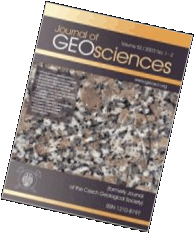 Export to Mendeley
Export to MendeleyBohemian Massif
Moldanubian Zone
geochemistry
granulites
alkali feldspar syenites
high-pressure melting
More articles on Deep crustal metamorphism and lower-crustal/upper-mantle processes
Original Paper
Hyperpotassic granulites from Blanský les (Moldanubian Zone, Bohemian Massif) revisited
Journal of Geosciences, volume 52 (2007), issue 1-2, 73 - 112
DOI: http://doi.org/10.3190/jgeosci.010
In the Blanský les granulite Massif (Moldanubian Unit, South Bohemia), built mainly by felsic calc-alkaline HP-HT garnet ± kyanite granulite, occur rare small bodies of hyperpotassic granulite with garnet (Plešovice type) or pyroxene (Lhotka type).
The Plešovice type is dominated by slightly perthitic K-feldspar and almandine-pyrope rich garnet, the latter variously retrogressed to biotite ± plagioclase. The other conspicuous euhedral crystals are apatite and zircon. In the rock occur also Zr-Nb-rich rutile and much rarer primary monazite; originally LREE-rich apatites decompose into small Th-poor, MREE-rich monazite grains.
The Lhotka type granulites contain pyroxene, often altered to actinolite, instead of garnet. The predominant perthitic K‑feldspar encloses a small amount of unmixed celsian. Typical are large euhedral crystals of apatite with small unmixed monazite grains; primary monazite is rare. Noteworthy is the occurrence of secondary Ti phases with high REE, Y and Zr, formed at the expense of the primary pyroxene.
The studied granulite types are highly potassic (K2O > 7 %, up to c. 14 %, K2O/Na 2O = 3.1-9.2 wt. %), silica-poor (SiO 2 < 65 %), with low contents of most major- and minor-element oxides, apart from K and P. Characteristic are high concentrations of Cs, Rb, Ba and U at variable enrichments in Zr and Hf. Whole-rock contents some HFSE (Ti, Nb and Ta) are extremely low. The REE patterns show marked negative Eu anomalies and variable LREE enrichments increasing with rising silica due to a conspicuous drop in HREE. The Sr-Nd isotopic ratios document the derivation from mature crustal sources (εNd337~ -5.5; 87Sr/ 86Sr 337 = 0.7272 and 0.7279 for the Plešovice and 87Sr/ 86Sr 337 = 0.7109 for the Lhotka types). Apatite saturation temperatures are high (~1070 °C), close to the previously estimated conditions of (re)crystallization for both calc-alkaline and hyperpotassic granulites. The zircon saturation temperatures tend to be more variable, some exceeding 1000 °C but many unrealistically low, reflecting effects of disequilibrium melting, heterogeneous distribution of accumulated crystals in the magma and/or sampling bias.
The hyperpotassic granulites are interpreted as Viséan igneous rocks. The parental magma could have originated by low degrees of HP-HT, non-eutectic partial melting. The low-scale melt was most likely expelled close to the HP-HT metamorphic peak or at early stages of decompression from common Moldanubian calc-alkaline granulites. This genetic link is documented by the presumed P-T conditions, similar age and complementary geochemical and Sr-Nd isotopic signatures. Subsequently the magma could have developed by garnet, apatite and zircon dominated fractional crystallization, with or without some crystal accumulation.
Webdesign inspired by aTeo. Hosted at the server of the Institute of Petrology and Structural Geology, Charles University, Prague.
ISSN: 1803-1943 (online), 1802-6222 (print)
email: jgeosci(at)jgeosci.org


IF (WoS, 2024): 1.3
5 YEAR IF (WoS, 2024): 1.4
Policy: Open Access
ISSN: 1802-6222
E-ISSN: 1803-1943